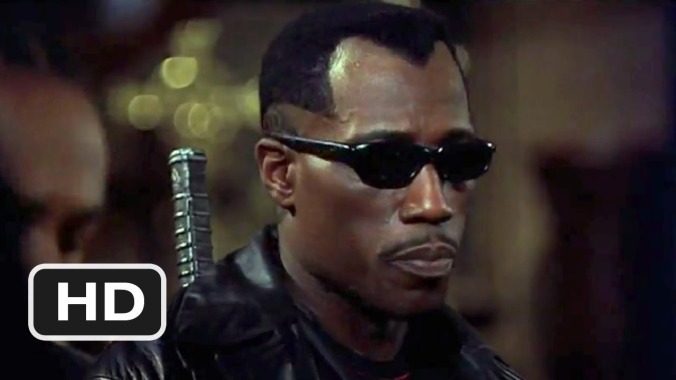Guillermo del Toro built his own blockbuster around the steely cool of a black Marvel superhero

Watch This offers movie recommendations inspired by new releases or premieres, or occasionally our own inscrutable whims. With the Academy Awards right around the corner, we’re suggesting the perfect pairings for this year’s Best Picture nominees—movies to watch with, or instead of, each of them.
Blade II (2002)
There’s never been a hit quite like Black Panther, a cultural phenomenon so widely seen, beloved, and discussed that it’s managed to overcome even the Academy’s historic immunity to cape-and-cowl fare, scoring superhero cinema its very first Best Picture nomination. But if there’s little precedent for the movie’s overwhelming success, there are antecedents mixed into its winning genre cocktail: a little James Bond, a little Shakespeare, and maybe more than a little Blade, that other Afrofuturistic franchise featuring a black Marvel superhero operating within a secret world, using a mixture of supernatural ability and high-tech weaponry to fell his foes. Stephen Norrington’s 1998 original is probably the most celebrated and iconic of this pre-MCU trilogy, maybe just by virtue of being first. But it’s the gory and kinetic second installment, directed by last year’s Best Picture recipient Guillermo del Toro, that taps a true vein of graphic novel fun, emphasis on the graphic. Like Black Panther, it’s a superhero movie that feels genuinely indebted to geeky comic-book storytelling (and imagery), all while crafting its own fantastic big-screen world.
The premise is pulp simplicity. A powerful subspecies of vampire—feral, pasty ghouls with jaws that nightmarishly detach and expand—is stalking and feeding on the “normal” kind. Fearful that these new predators on the block will turn on humanity once they’ve done his job for him, day-walking vamp hunter Blade (Wesley Snipes, having a ball) reluctantly agrees to a ceasefire with the enemy. For del Toro, this standard comic-book alliance—what Mr. Glass might identify as “the good guys and the bad guys teaming up”—is yet another opportunity to remix film history, like a kid smashing together his action figures. Here, the lifelong monster fanatic arranges a title fight between two different types of movie vampire, pitting a post-Lost Boys, post-Anne Rice class of relatively refined bloodsuckers against mindless, screeching killing machines designed to resemble the granddaddy of cinematic vamps, Nosferatu. (There’s a touch of James Cameron’s Aliens, too, in scenes of trash-talking, heavily armed grunts creeping through dimly lit tunnels, swarms of hostiles afoot.)
With its kung-fu fight scenes, practical creature effects, and advanced underground labs and lairs, Blade II plays a little like a dry run to del Toro’s true superhero passion project, the Hellboy series. But if this is a more work-for-hire blockbuster, it’s arguably a purer, more entertaining blast of action-horror-fantasy nonsense. A love for comic-book tropes runs thick through the film’s bloodstream, evident in everything from a scene where ninja vampires drop silently from the ceiling of the Blade Cave to the introduction of a colorful posse called The Blood Pack, which resembles any number of supervillain teams featuring one-note characters with cool names and costumes. (Del Toro enhances the badass factor of his vampire take on, say, The Marauders by filling out their ranks with actors like Ron Perlman and Hong Kong martial-arts great Donnie Yen.)
Though there’s a germ of a moral dilemma in Blade’s decision to side with the vampire elite over a kind of “underclass” of ravenous monsters, who the film depicts and even describes as drug addicts, Blade II lacks anything like the political conscience of Black Panther. It has no pretensions to do more than deliver flavorful, over-the-top mayhem. But perhaps this superlative sequel did lay some groundwork for Ryan Coogler’s zeitgeist smash—and not just because both films end with someone watching the sun rise or fall as they die, the hero there with them in their final moments. In its antagonistic clash of personalities, the way its multicultural cast of characters is constantly bantering and squabbling, Blade II anticipated the interpersonal conflicts of the MCU. It also demonstrated that a comic-book movie could be at once loyal to the spirit of its source material and provide a vehicle for a director’s idiosyncratic interests. In other words, you can see a glint of Wakanda in the gleam of Blade’s steel.
Availability: Blade II is available to rent or purchase from iTunes, VUDU, and most of the other major digital services. It can also be obtained on Blu-ray or DVD from Netflix, Amazon, or possibly your local video store/library.